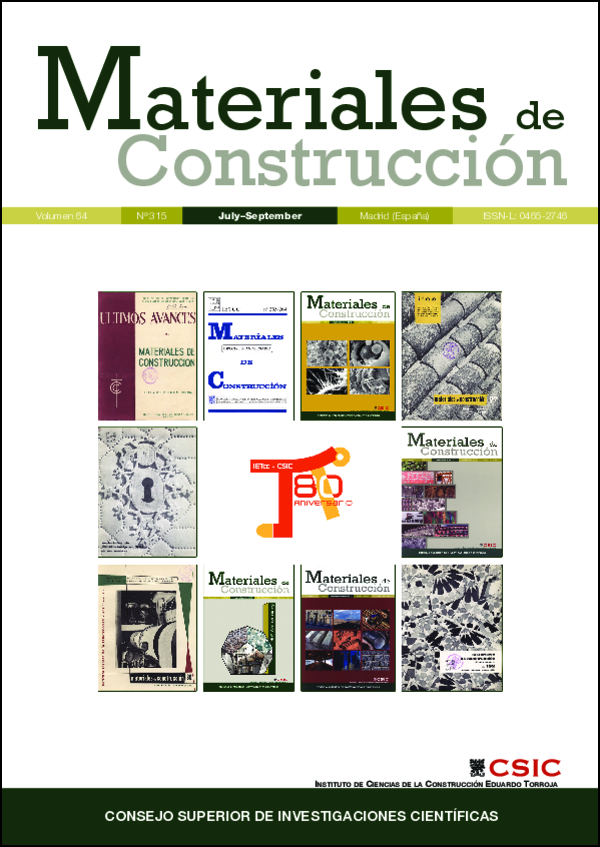Efecto del contenido de aluminato de estroncio y hemihidrato sobre las propiedades de un cemento de sulfoaluminato de calcio
DOI:
https://doi.org/10.3989/mc.2014.04413Palabras clave:
Aluminato de estroncio, Etringita, SulfoaluminatoResumen
Se investigó el efecto de la adición de aluminato de estroncio (SrAl2O4) sobre las propiedades de un cemento de sulfoaluminato de calcio (C4A3Ŝ). Se prepararon muestras mezclando C4A3Ŝ, hemihidrato (CaSO4· ½H2O, CŜH0.5) y 0, 10 o 20% e.p de SrAl2O4 (SrA). La cantidad de CŜH0.5 fue de 15, 20 o 25% e.p. basado en la cantidad de C4A3Ŝ. Las relaciones agua/cemento utilizadas fueron 0.4 y 0.5. Las muestras fueron curadas hasta 28 d. Se evaluó el tiempo de fraguado y la resistencia a la compresión. Los productos de hidratación se caracterizaron mediante DRX y MEB. El tiempo de fraguado se retardó hasta 42 minutos con la adición del SrAl2O4 comparado con las muestras sin adiciones. Las muestras con 25% e.p. de yeso y 20% e.p. de SrAl2O4 desarrollaron la mayor resistencia a la compresión alcanzando 60 MPa a 28 d de curado. Los análisis por MEB y DRX muestran como principal producto de hidratación a la etringita (C6AŜ3H32), cuya morfología se observa como cristales aciculares.
Descargas
Citas
1. Odler, I. (2000) Special inorganic cements, E & FN SPON, London.
2. Juenger, M.C.G.; Winnefeld, F. (2011) Advances in alternative cementitius binders. Cem. Concr. Res., 41 [12], 1232–1243. http://dx.doi.org/10.1016/j.cemconres.2010.11.012
3. Propescu, C.D. (2003) Industrial trial production of low energy belite cement. Cem. Concr. Comp., 25 [7], 689–693. http://dx.doi.org/10.1016/S0958-9465(02)00097-5
4. Aranda, M.A.G.; De la Torre, A.G. (2013) Sulfoaluminate cement, Ed. Pacheco-Torgal, F., Jalali, S., Labrincha, J., John, V. M. (Eds.), Eco-efficient concrete, Cambridge.
5. Saju, S.; Majling, J. (1993) Phase compatibility in the system CaO-SiO2-Al2O3-Fe2O3-SO3 referred to sulphoaluminate belite cement clinker. Cem. Concr. Res., 23 [6], 1331–1339. http://dx.doi.org/10.1016/0008-8846(93)90070-P
6. Quillin, K. (2001) Performance of belite-sulfoaluminate cements. Cem. Concr. Res., 31 [9], 1341–1349. http://dx.doi.org/10.1016/S0008-8846(01)00543-9
7. Klein, A. (1965) Formation of Ettringite by Hydration of a System Containing an Anhydrous Calcium Sulfoaluminate. J. Am. Cer. Soc., 48 [8], 435–436. http://dx.doi.org/10.1111/j.1151-2916.1965.tb14786.x
8. De la Torre, A.G.; Cuberos, A.J.M. et al. (2011) In situ powder diffraction study of belite sulfoaluminate clinkering. Journal of Synchrotron Radiation, 18 [3], 506–514. http://dx.doi.org/10.1107/S0909049511005796 PMid:21525661
9. Glasser, F.P.; Zhang, L. (2001) High-performance cement matrices based on calcium sulfoaluminate–belite compositions. Cem. Concr. Res., 31 [12], 1881–1886. http://dx.doi.org/10.1016/S0008-8846(01)00649-4
10. Arjunan, P. (1999) Sulfoaluminate-belite cement from low- calcium fly ash and sulfur rich and other industrial by-products. Cem. Concr. Res., 29 [8], 1305–1309. http://dx.doi.org/10.1016/S0008-8846(99)00072-1
11. Winnefeld, F. (2010) Hydration of calcium sulphoaluminate cements experimental findings and thermodinamic modeling. Cem. Concr. Res., 40 [1], 1239–1247. http://dx.doi.org/10.1016/j.cemconres.2009.08.014
12. Ambroise, P.J. (2004) New applications of calcium sulfoaluminate cement. Cem. Concr. Res., Vol. 34 [4], 671–676. http://dx.doi.org/10.1016/j.cemconres.2003.10.019
13. Havlica, S.S. (1991) Hydration behaviour of sulphoaluminate belite cement in the presence of various calcium sulphates. Thermochimica Acta, 175 [1], 45–52. http://dx.doi.org/10.1016/0040-6031(91)80244-D
14. Hargis, C.; Kircheim, A. (2013) Early hydration of calcium sulfoaluminato (synthetic ye'elemite, C4A3S^) in the presence of gypsum and varying amounts of calcium hydroxide. Cem. Concr. Res., 48 [1], 105–115. http://dx.doi.org/10.1016/j.cemconres.2013.03.001
15. Wang, Y.; Su, M. (1994) The third cement series in China. World Cem., 25 [8], 6–10.
16. Zhang, L.; Su, M.; Wang, Y. (1999) Development of the use of sulfo- and ferroaluminate cements in China. Adv. Cem. Res., 11 [1], 15–21. http://dx.doi.org/10.1680/adcr.1999.11.1.15
17. Beretka, J.; Marroccoli, M. (1996) The influence of C4A3S^ content and W/S ratio on the performance of calcium sulfoaluminate-based cements. Cem. Concr. Res., 26 [11], 1673–1681. http://dx.doi.org/10.1016/S0008-8846(96)00164-0
18. Winnefeld, F.; Barlag, S. (2010) Calorimetric and thermogavimetric study on the influence of calcium sulfate on the Figure 6. Micrographs of samples containing 15(a), 20(b) and 25(c)w% of hemihydrate and 20wt% of SrAl2O4 after 28 d of curing hydration of ye'elimite. J. Therm. Anal. Calorim., 101 [3], 949–957. http://dx.doi.org/10.1007/s10973-009-0582-6
19. Evju, C.; Hansen, S. (2001) Expansive properties of ettringite in a mixture of calcium aluminate cement, Portland cement and β-calcium sulfate hemihydrate. Cem. Concr. Res., 31 [2], 257–261. http://dx.doi.org/10.1016/S0008-8846(00)00495-6
20. Braniski, A. (1957) Barium and strontium cements, Zement-Kalk-Gips, 5, 176–184.
21. Chatterjee, A.K. (2009) Re-examining the prospects of aluminous cements based on alkali-earth and rare-earth oxides. Cem. Concr. Res., 39 [11], 981–988. http://dx.doi.org/10.1016/j.cemconres.2009.07.027
22. ASTM C-204, Fineness of Hydraulic Cement by Air Permeability Apparatus, 1995 Annual Book of ASTM Standards. Section 4. Construction. Vol. 04.01. Cement, Lime, Gypsum.
23. BS EN 196-6: 2010. Methods of testing cement. Part 6: Determination of fineness. London, British Standards Institute.
24. ASTM C-191, Test Method for Time of Setting of Hydraulic Cement by Vicat Needle, 1995 Annual Book of ASTM Standards. Section 4. Construction. Volume 04.01. Cement, Lime, Gypsum.
25. BS EN 196-3: 2005. Methods of testing cement. Part 3: Determination of setting and soundness. London, British Standards Institute.
26. ASTM C 150 Standard Specification for Portland cement, 2004 Annual Book of ASTM Standards. Section 4. Construction. Vol. 04.01. Cement, Lime, Gypsum.
27. BS EN 197-1: 2000. Cement. Composition, specifications and conformity criteria for common cements. London, British Standards Institute.
28. Quennoz, A.; Scrivener, K.L. (2012) Hydration of C3A–gypsum systems. Cem. Concr. Res., 42 [7], 1032–1041. http://dx.doi.org/10.1016/j.cemconres.2012.04.005
29. Motzet, H.; Pöllmann, H. (1999) Synthesis and characterisation of sulfite-containing AFm phases in the system CaO-Al2O3-SO2-H2O. Cem. Concr. Res., 29 [7], 1005–1011. http://dx.doi.org/10.1016/S0008-8846(99)00082-4
Publicado
Cómo citar
Número
Sección
Licencia
Derechos de autor 2014 Consejo Superior de Investigaciones Científicas (CSIC)

Esta obra está bajo una licencia internacional Creative Commons Atribución 4.0.
© CSIC. Los originales publicados en las ediciones impresa y electrónica de esta Revista son propiedad del Consejo Superior de Investigaciones Científicas, siendo necesario citar la procedencia en cualquier reproducción parcial o total.
Salvo indicación contraria, todos los contenidos de la edición electrónica se distribuyen bajo una licencia de uso y distribución “Creative Commons Reconocimiento 4.0 Internacional ” (CC BY 4.0). Consulte la versión informativa y el texto legal de la licencia. Esta circunstancia ha de hacerse constar expresamente de esta forma cuando sea necesario.
No se autoriza el depósito en repositorios, páginas web personales o similares de cualquier otra versión distinta a la publicada por el editor.
















